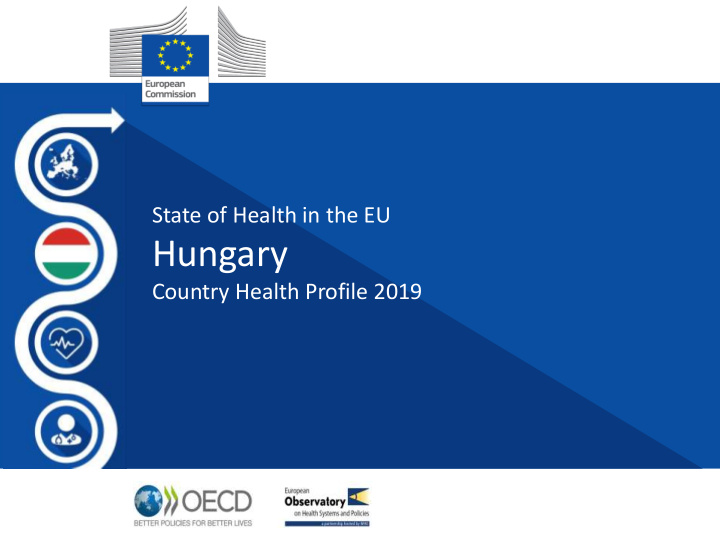



State of Health in the EU Hungary Country Health Profile 2019
Country Health Profile
Health in Hungary
LE at birth in Hungary remains almost 5 years shorter than in the EU Inequalities in life expectancy by gender and socio-economic status are also marked
Deaths from CV diseases have decreased but remain the leading cause of deaths Also, Hungary had the highest cancer mortality rate in the EU in 2016, with lung, colorectal, liver and breast cancers the most frequent causes of cancer-related death
Many years of life after 65 are lived with some disabilities - Two-thirds of Hungarians aged 65 and over report having at least one chronic disease (12 percentage points higher than the EU average). - And one in six report some limitations in basic activities of daily living.
Risk factors
Hungarians have higher rates of risky health behaviours than most EU countries
Hungarians have higher rates of risky health behaviours than most EU countries • Hungarians are among the heaviest smokers in the EU: More than one in four adults smoked daily in 2014 – the third highest rate in the EU. • Adult obesity is also among the highest in the EU: one in five adults were obese in 2017, a rate that has increased steadily over the last decade. • Overweight and obesity are also a growing problem in children , with nearly one in five 15-year-olds overweight or obese in 2013-14. • Alcohol consumption among Hungarian adults has decreased over the past decade but in 2017 remained more than 10 % above the EU average : 11.1 litres per capita compared with 9.9 in the EU.
Health system in Hungary
Hungary spends less on health care than most other EU countries Health spending accounted for 6.9 % of GDP in 2017, well below the EU average. The public share of health spending (government and compulsory insurance) accounts for only slightly more than two-thirds of total health expenditure.
Inpatient care and pharmaceuticals represent the largest cost items in the health system At 31 %, inpatient care is only slightly above the EU average of 29 %, while pharmaceuticals (also 31 %) well exceed the EU figure (18 %)
Health workforce shortages are a major concern
Effectiveness of the health system
Many deaths could be avoided through better prevention and health care Nearly 30 000 deaths could have been avoided in 2017 through effective public health and prevention interventions, and a further 16 000 deaths through more appropriate and timely health care.
Vaccination policy is very successful in children
The primary care sector can be strengthened
Accessibility of the health system
High OOPs create financial hardship - OOPs payments accounted for more than one-quarter of health spending in Hungary – one of the highest proportions in the EU and nearly twice the EU average. - Almost 12 % of households in Hungary faced catastrophic spending on health in 2015, one of the highest levels across the EU.
Health workforce shortages create barrier to access • Hungary has fewer health professionals than the EU average • But the health workforce is also unevenly distributed across the country: the central region has almost twice as many doctors per capita than the north, and shortages in each region are concentrated in rural areas • The progressive retirement of a substantial proportion of Hungary’s practicing doctors will worsen regional disparities and impair access to care unless a sufficiently large number of new doctors replace them. • Recent increases in health professionals wages have started to produce effect and improved retention.
Resilience
Public spending on health decreased following the economic crisis - Health is not a high priority for Hungary: only 10 % of all government spending is allocated to health, compared with an average of 16 % in the EU as a whole. - Hungary faces low fiscal sustainability risks in the short run. Conversely, in the medium and long term, the risks are high.
Efficiency gains exist • The hospital sector remains very predominant and healthcare focus could be shifted more to primary care. • More reliance on day-surgery could increase efficiency of hospital spending • Recent projects to strengthen the primary care sector showed promising results and would help to pursue the focus on prevention (advanced practice nurse, Swiss Hungarian Primary Health Care Development Model Programme)
Main messages
Main messages The LE of the Hungarian population has increased in recent years but remains almost 5 years below the EU average. Despite recent efforts on Health prevention, behavioral risk factors still have a major impact on the health of the population. The health sector remains chronically underfunded and health does not appear to be a high priority. The public share accounts for only two- Funding thirds of health expenditure, resulting in high levels of out-of-pocket spending (27 %) compared to the EU average (16 %). Overall, health care provision remains highly hospital-centric and primary care does not yet play a prominent role in Hungary. There have PHC been some efforts in recent years to shift more care to the outpatient sector (group practices for general practitioners, task shifting, etc.). Health professionals are not in sufficient numbers and are not evenly Access distributed across the country. OOPs are much higher than in the EU and lead to high rates of catastrophic expenditure on health.
ec.europa.eu/health/state oecd.org/health/health-systems/country-health-profiles-EU.htm euro.who.int/en/about-us/partners/observatory/publications/country-health-profiles
Recommend
More recommend